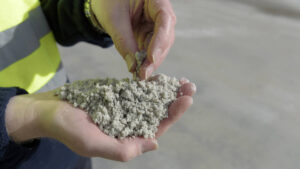Car buyers are developing a taste for electric vehicles and this lithium boss says their appetite is growing

Pic: Alexi J. Rosenfeld/Getty Images via Getty Images
- A booming South East Asian market driven by consumer tastes will propel EV sales to new heights
- Pan Asia Metals is aiming to develop local lithium assets to supply converters in Thailand, Asia’s fourth largest car manufacturer
- Low cost manufacturing environment key to develop EV supply chain: PAM’s Paul Lock
The leading lithium proponent in South East Asia says electric vehicle sales are now being drawn from consumer demand rather than government subsidies in a sign the demand projections for battery metals won’t disappoint.
Including China and India, some 55% of the world’s passenger vehicles are made in the developing manufacturing economies of South East Asia, with 14% of passenger vehicle sales worldwide now electric — a forecast growth rate this year of 36%.
Many of those countries outside of China, like Thailand and Vietnam, want to see materials for their future EV sectors to be sourced locally.
It places Pan Asia Metals (ASX:PAM) in a good spot to become one of the few suppliers of material to the local market from its Reung Kiet and Bang I Tum lepidolite prospects once the chilling effect falling prices in China this year is having on the market subsides.
PAM managing director Paul Lock said the growth of the electric mobility sector in Asia was quickly being driven from the side of the vehicle buyer.
Along with rising interest in passenger EVs, with over 500 models now on the market, around 49% of sales in the scooter market, a key segment in South East Asia, were now electric.
“Very quickly, it’s started being pushed by the driver,” Lock said.
“And the reason is anyone who gets an EV does start to see that their energy costs go down.
“In an ICE you’ve got 80% losses at the wheel, in an EV 33% losses before regenerative gains. So absolutely massive.
“In Asia, there are electric cabs everywhere. So when a cab driver in Jakarta can make money on their electric cab, you know that it’s working. So there’s that litmus test.”
Local content
While the US is looking to boost its electric vehicle penetration through the Inflation Reduction Act, a piece of legislation incentivising US automakers to produce cars locally using domestic or free trade approved materials, Lock says Asian producers willl not let their market share go so fast.
“In ASEAN, we’ve got 640 million people. A third of those moving into the middle class or are in the middle class, and a big chunk is following behind,” Lock said.
“If you think about Australia’s population at say 25 million, it’s literally less than 5% of South East Asia.
“Thailand is the largest (car) producer in South East Asia and the fourth largest in Asia. And most, if not all, the big brands are represented there.
“The Chinese are moving in, so BYD and GWM and a few others are building their EV factories right now and producing and Mercedes is producing their EQS EV there.”
In a presentation last month at the Melbourne EV Motor Show, Lock presented JP Morgan research showing global lithium demand would rise 4.6x on 2022 levels to 3.2Mt in 2030, 7.7x to 5.4Mt by 2035 and 9.4x to 6.6Mt by 2040.
Last week the Bangkok Post forecast Thailand’s EV sales to lift 151% to 80,700 units in 2023.
At the same time they are keen to increase the proportion of their vehicles made with batteries produced in country.
That could be extremely handy to PAM, whose two prospects are among the only advanced domestic projects in the country.
At Reung Kiet it boasts 10.4Mt of lepidolite rich ore at 0.44% Li2O. Last year test work showed its mineralisatoion could be amenable to ore sorting to increase feed grades.
At Bang I Tum, a former tin mine, PAM has set an exploration target of 16-25Mt at 0.4-0.7% Li2O.
“The Thai government actually introduced a mining policy, which is supporting exploration for critical metals and production in country,” Lock said.
“If we had a copper mine, a copper-lead-zinc project, they couldn’t care less, because it’s not really of interest to them.
“Thailand and Malaysia, it’s all about S-curve industries and that big GDP uplift in the future. And that’s where we’re looking.”
Grade’s not king
Lepidolite has been rarely touched by ASX players, who have focused on spodumene bearing pegmatites commonly found in WA.
Typically lower in grade, many of the Chinese operations now sitting at the upper end of the cost curve are lepidolite mines, able to switch on and off as lithium carbonate prices rise and fall above and below US$25,000/t.
But Lock says the market is little understood in the West. He likens the mines at the top end of the cost curve, some of which grade as low as 0.1% Li2O, to the alluvial Indonesian tin mining that switches on when prices for that commodity are near record highs.
Reung Kiet is closer to the 0-3-0.6% grade range of Chinese deposits that sit comfortably around the middle of the global cost curve (and are cheaper to process than third party spodumene.)
Thailand is a low cost manufacturing environment, and Lock sees additional benefits over the typical hard rock supply chain through which WA’s spodumene concentrate suppliers sell to chemical producers in China.
“Our projects are all located on the grid, hydropower nearby, but in sparsely populated environments, so when I talked about strategic location, we’re located next to very good infrastructure,” he said.
“We’re also located near the car industry.”
While lepidolite may be mined at lower grades out of the ground, gaps in concentrate grades are getting smaller.
“What’s really interesting, a lot of people look at lepidolite and say it’s low grade,” Lock noted. “We’ll produce a concentrate of 3-3.5% Li2O.
“MinRes’s concentrate grade out of Mt Marion, their average for FY23 was 3.8% Li2O, Pilbara’s is 5.25%, Greenbushes would be higher but their grades are getting lower.
“SC6 is a dream, it’s going to be sort of 4-5%, so in a low cost environment next to infrastructure and our whole market including inputs, lepidolite works and that’s why it works in China.”
Downstream support
PAM has two major value-adding initiatives in the works.
One is an MoU with Vietnam’s VinES, part of US$40 billion capped conglomerate VinGroup. VinES is planning to construct LFP batteries in a JV with US$5.6b capped Gotion out of China to feed its Vinfast car brand.
PAM and VinES will look into converting lithium chemicals in Vietnam to help build out the supply chain locally.
In Thailand, PAM is looking to use its concentrate to supply a chemical processing plant in an MoU with IRPC, a listed entity housed within State-owned US$30 billion Thai oil and gas major PTT which holds an industrial zone in Rayong Province.
Both are looking at expanding further into cathode active material production, the step before battery production and assembly, with the potential help of a technical partner.
Lock said working with big local names provided confidence around finance and a “real pathway to production”.
On the mining front a resource upgrade is expected soon at Reung Kiet with a PFS in the works, with an inaugural resource on the cards at Bang I Tum.
Mining licence applications are also being prepared for submission late this year or early next year.
Countering the cycle
Meanwhile, PAM has also made a counter-cyclical move into the Chilean brine scene at time when nerves are growing around government policy in the South American nation.
Home to around 25% of lithium raw material production and the second largest producer outside Australia, concerns Chile could nationalise lithium production on its salt lakes have stoked fears around investing in the country.
But that has created an opportunity for companies keen to go against the grain.
PAM entered into binding MoUs earlier this year to acquire six lithium brine and clay licences at the Tama-Atacama project in northern Chile 290km north to south and over an area of around 1400km2.
Significant lithium grades ranging as high as 2200ppm Li have been found at the licences.
Chilean lithium production is dominated by major players SQM and Albemarle, while Government run copper giant Codelco has signalled its intent to expand its lithium interests, entering talks with the ASX-listed owner of the Maricunga project Lithium Power International (ASX:LPI).
Lock believes commentators have it wrong on Chile, with the project on the low elevation Salar Dolores, Pintados and Belavista salars rating as a counter-cyclical play.
“The Chilean government has said that for non-strategic assets, that’s anything outside of Atacama and Maricunga, a private company can lodge for a mining licence for lithium, and can elect to invite the government if it wants, a good example is AIM-listed Clean Tech Lithium,” Lock said.
“One of their most recent announcements actually talks about the policy and they’ve submitted mining license applications. So I think the whole nationalisation thing is way overplayed.”
Chile’s left-leaning president Gabriel Boric will also face a challenge progressing changes to its mining policy after right wing factions won a key vote to select advisors on a proposed new constitution earlier this year.
The next presidential election will take place in 2025.
Pan Asia Metals (ASX:PAM) share price today
Related Topics

UNLOCK INSIGHTS
Discover the untold stories of emerging ASX stocks.
Daily news and expert analysis, it's free to subscribe.
By proceeding, you confirm you understand that we handle personal information in accordance with our Privacy Policy.








